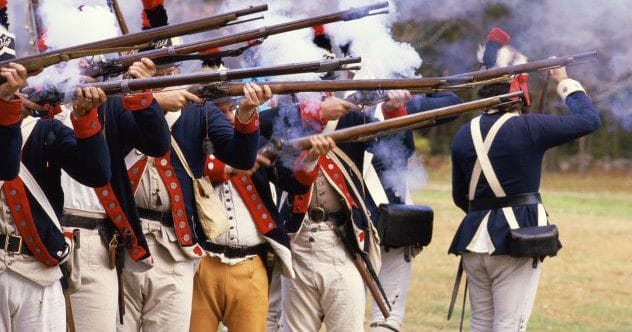Would you believe the American Revolution was fought on the far southwestern tip of Europe—and no American forces were involved? Or that the American Civil War saw fighting off the coast of France? Throughout history, many infamous wars included battles fought in entirely unexpected places.
In this list, we’ll look at ten lesser-known battles that occurred in surprising locations. From vicious fighting halfway around the world to a unique online war, these skirmishes defy expectations.
Related: Top 10 Poorly Planned Battles
10 The Virtual Violence of B-R5RB
Battles are fought in the real world, right? Not all battles are like that. Even virtual battles can cause destruction—and cost big bucks!
The Battle of B-R5RB took place in 2014 in the online game EVE Online. This conflict came with a hefty (real-world) price tag of $300,000. The chaos began when a player group “lost” control of the star system B-R5RB after failing to pay their monthly “rent.” This oversight sparked a frenzy among thousands of players worldwide.
The system held immense strategic importance as a staging area for a major in-game alliance. What followed was an unprecedented battle witnessed by over 12,000 viewers through a live stream. Lasting nearly 22 hours, this clash became one of the largest events in online gaming. Players paid real money to acquire weapons and defeat their virtual foes. Who knew online gaming had such real-world consequences? [1]
9 Americans vs. Aussies in WWII
The Battle of Brisbane was a lesser-known conflict during World War II. It unfolded in Brisbane, Australia, and shockingly, it was between Australians and their American allies. Although not officially an armed battle, tensions escalated for two days in November 1942. A riot turned into a full-scale fight.
Initially welcomed, American troops had been stationed in Brisbane for defense against Japan after Pearl Harbor. But by late 1942, many Aussies felt the Americans overstayed their welcome. American General Douglas MacArthur made derogatory remarks about Australian hospitality. Soon, many local Australians resented the American soldiers.
On November 26, 1942, a misunderstanding led to a verbal fight. Australian soldiers hurled insults at an American, leading to a confrontation with a military police officer. The officer was punched, and chaos ensued. More than 3,000 soldiers clashed on the streets of Brisbane. An American MP fatally shot an Australian soldier and wounded others as the fight intensified. Countries that were nominal allies failed to come together. [2]
8 A Revolutionary War Fight in… Spain?
Friends can be crucial, especially during conflict. This was evident for the Americans in the Great Siege of Gibraltar. The battle was a significant event during the American War of Independence—and American involvement was completely absent.
In the 1770s, Spain and France joined forces to seize Gibraltar from Britain, disguising their actions as supporting the American Revolution. Secretly, they didn’t care much for our revolution. Instead, capturing Gibraltar was a crucial step toward their ultimate goal of invading Britain.
Britain recognized the strategic value of Gibraltar. They dedicated considerable time and resources to fortifying its defenses long before the attack began. When Spain and France blockaded the region in 1779, the British were well-prepared. Despite facing over 40,000 French and Spanish soldiers, 7,000 British infantrymen defended Gibraltar. The war waged for three years and seven months until a truce was reached. This conflict exemplified resilience and effective defensive measures. [3]
7 A Revolutionary War Fight in… India?
During the Revolutionary War, an unexpected final battle took place long after Yorktown. It didn’t involve any American troops, despite being part of the show. In India, the Kingdom of Mysore had been resisting British rule. When their sultan passed away, the British saw an opportunity to crush the resistance.
Sending soldiers to India, the British met opposition from France and the people of Mysore. In 1783—two years after Yorktown—the British and French armies clashed. This battle occurred three months before the signing of the Treaty of Paris. The Anglo-Mysore War saw significant suffering for both sides. News of the imminent end of the war in America reached the British forces, leading to the battle’s cessation. The Revolutionary War’s conclusion was not confined to Yorktown as allies sought their own gains. [4]
6 German U-Boats in Canada
The Battle of the St. Lawrence was an unlikely naval clash during World War II. German U-boats penetrated a Canadian river far from the Atlantic Ocean. By May 1942, they had reached Montreal. These Nazi submarines destroyed 23 Canadian and Allied ships, costing the Allies 70,000 tons of vital supplies.
The Canadian defense was ill-prepared for submarine attacks. A ferry carrying women and children from Nova Scotia to Quebec also succumbed to the depths. There was no aerial support or substantial defenses along the waterway initially. Thankfully, defenses were eventually deployed. Canada fought back against the German attackers. Had the Canadians not made a stand in the St. Lawrence, who knows how far the Germans could have gotten. [5]
5 A Mock Battle in Manila
The Battle of Manila Bay in 1898 played a crucial role in the Spanish-American War. U.S. forces triumphed over the Spanish fleet, effectively concluding the war. But that wasn’t the end of the story.
Simultaneous to that big-time battle, a Philippine resistance leader named Emilio Aguinaldo rallied against the Spanish on land, proclaiming independence. Despite this, both the Spanish and the Americans refused to recognize it. Land-locked Spanish soldiers found themselves trapped between American reinforcements and Philippine forces.
During negotiations, American and Spanish forces reached an agreement: a phony “battle” to dispel the Filipino resistance fighters. The staged “battle” took place on August 13, 1898. The Americans “demolished” the remnants of the Spanish fleet, resulting in the Spanish “surrendering” for good. In turn, it left Aguinaldo and his men demoralized. The United States took over Spain’s position of power after this second “surrender.” [6]
4 A Brutal Battle on American Soil
The United States hasn’t fought a foreign power on its mainland for centuries. During World War II, there was one lesser-known fight that occurred on American soil: the Battle of Attu. This battle took place in May 1943 on Attu Island, part of Alaska’s Aleutian Islands.
The Japanese attacked the islands in June 1942, intending to set up bases and advance further into North America. On May 11, 1943, 12,500 American soldiers engaged in a two-week battle against the Japanese forces. Despite the island’s small size, the fighting was fierce, and the terrain was harsh.
Over 1,700 American soldiers fell to enemy forces, and another 2,100 succumbed to diseases and non-battle injuries. Conditions became so dire that some soldiers resorted to throwing grenades into the sea to catch fish for food. Approximately 2,350 Japanese soldiers died, many by suicide. The battle is not well known because of its unlikely location on remote Alaskan soil. [7]
3 A British Great Lakes Naval Skirmish
The War of 1812 involved a vicious fight against the British. Several battles occurred in unexpected outposts. In 1813, six British ships were sighted in Lake Erie to reclaim control from American forces.
Despite the British having better long-range weapons, the Americans possessed more ships armed for close combat. Initially hindered by unfavorable winds, the Americans gained an advantage when the winds shifted. The American flagship, the USS Lawrence, suffered heavy damage.
Captain Oliver Perry and his crew navigated the Lawrence through British attacks and reached the USS Niagara. There, he assumed control of the sister ship. The undamaged Niagara swiftly penetrated the British ranks. Four British vessels surrendered, while the remaining two were captured. As a result, the British abandoned Detroit. [8]
2 The Misnamed Battle of Tannenberg
Battles usually get their names from the location or the cause. However, the 1914 Battle of Tannenberg breaks that pattern. It didn’t occur in the German city of Tannenberg. It was named after the Battle of Tannenberg in 1410 out of spite!
In 1410, Slavic forces defeated the Teutonic Knights at Tannenberg. In World War I, a battle between German and Russian forces took place in Allenstein, in modern-day Poland. The Germans emerged victorious, inflicting a brutal defeat on the Russians, who lost 120,000 men. To glorify German military strength, the battle was named for the earlier one. Even though Allentstein was located miles away from Tannenberg, it became the (second) Battle of Tannenberg. [9]
1 An American Civil War Battle Was Fought Where?!
The American Civil War was fought between the Union and the Confederacy. During this war, the Battle of Cherbourg took place in France. In June 1864, the Confederate vessel CSS Alabama and the Union ship USS Kearsarge engaged in a naval battle.
The Alabama had been seeking repairs in France. The Kearsarge discovered its presence. After several days, the captains agreed to a duel in international waters. The Alabama was ill-prepared for combat, with inferior ammunition. The Union ship emerged victorious, causing the Alabama to sink off the French coastline. The Battle of Cherbourg highlights the unexpected encounters that can take place during a conflict! [10]
From virtual realms to foreign lands, history is full of surprising battles fought in unexpected places. These conflicts remind us that war’s reach extends far beyond the anticipated battlegrounds.
What do you think about battles fought in unexpected places? Leave your comment below!










